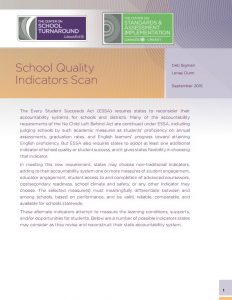School Quality Indicators Scan
Deb Sigman & Lenay Dunn, WestEd
The Every Student Succeeds Act (ESSA) requires states to reconsider their accountability systems for schools and districts. Many of the accountability requirements of the No Child Left Behind Act are continued under ESSA, including judging schools by such academic measures as students’ proficiency on annual assessments, graduation rates, and English learners’ progress toward attaining English proficiency. But ESSA also requires states to adopt at least one additional indicator of school quality or student success, and it gives states flexibility in choosing that indicator.
In meeting this new requirement, states may choose non-traditional indicators, adding to their accountability system one or more measures of student engagement, educator engagement, student access to and completion of advanced coursework, postsecondary readiness, school climate and safety, or any other indicator they choose. The selected measure(s) must meaningfully differentiate between and among schools, based on performance, and be valid, reliable, comparable, and available for schools statewide.
These alternate indicators attempt to measure the learning conditions, supports, and/or opportunities for students. Included are a number of possible indicators states may consider as they revise and reconstruct their state accountability system.

